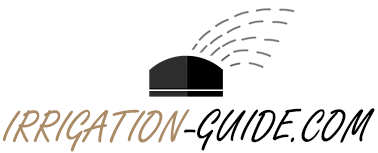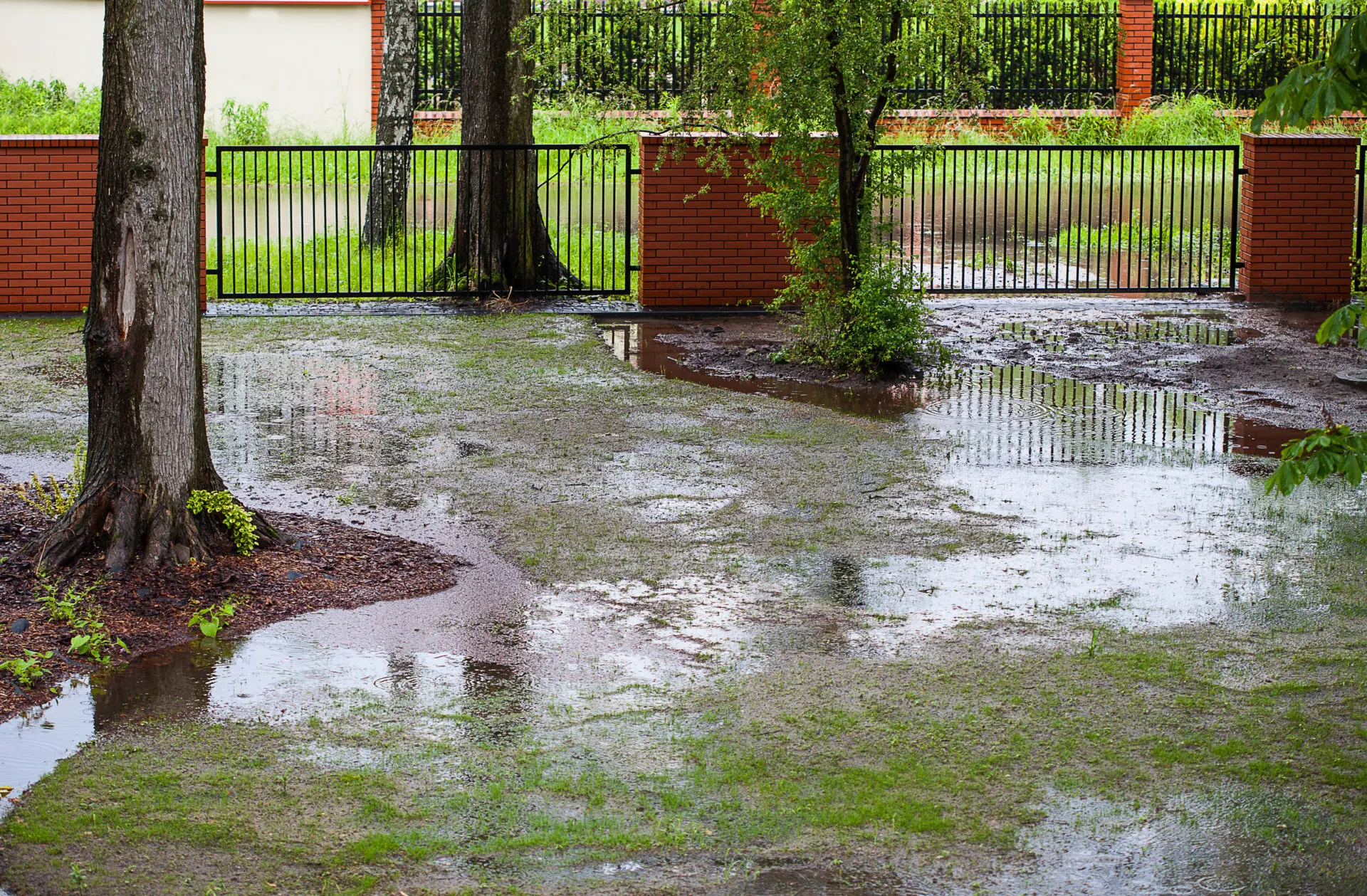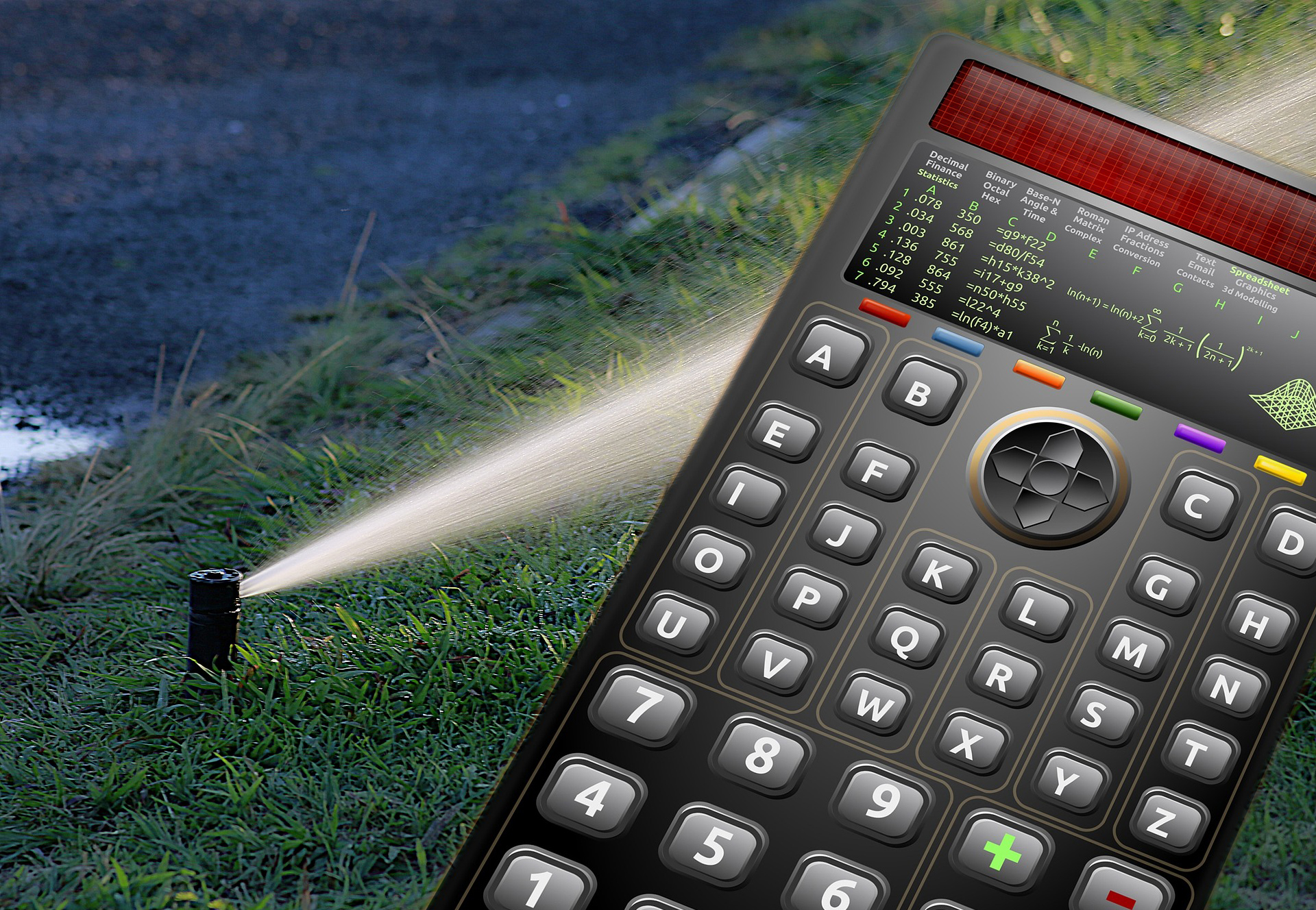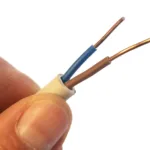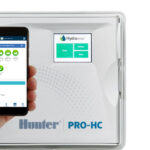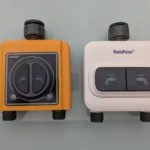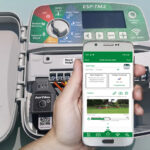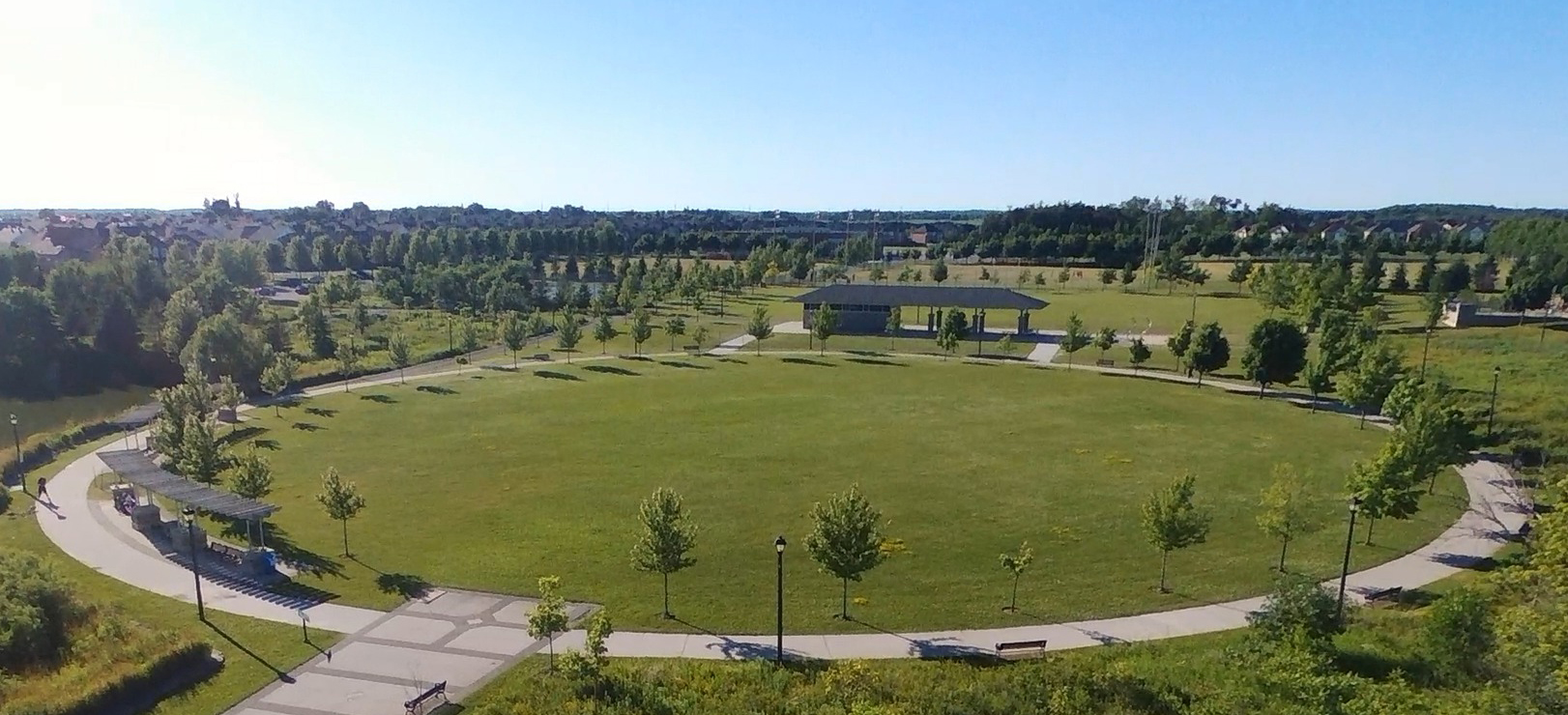There are also certain risks associated with the operation of an automatic irrigation system. Here you can find out what these are, how relevant they are for your own situation and which methods you can use to secure them.
It’s easy to overlook this at first glance, but automatic irrigation also harbors two major risks:
- Irrigation does not stop as soon as it should and continues uncontrolled
- The irrigation should be watering, but it isn’t
Especially the first point can lead to big problems.
Irrigation continues uncontrolled
Automatic irrigation is usually initiated and ended by a valve that opens and later closes again. If there is a defect in the valve so that it no longer closes or no longer closes properly, the irrigation continues.
If the water is drawn from a public network, this can lead to a very high water bill if you only notice the error late, for example because you are on vacation or do not visit the area to be irrigated regularly. Pumping water from a well only incurs the additional cost of electricity, but of course you may be wasting many thousands of liters of water.
Even more dangerous and expensive the effects of uncontrolled water leakage can be: At some point, the ground can no longer absorb any more water and, in the worst case, this will run into the basement, under the terrace, on to the neighbors or flush out paths or undermine foundations. That can get really expensive.
Irrigation is not carried out
This can also happen due to a defective valve that does not open as planned and therefore does not let water through. Or a failure of the irrigation computer, problems with the pump or a pressure switch, faulty sensors or a manual valve that was closed by mistake.
This damages lawns and plants in the garden that do not receive a scheduled supply of water. If the error is not noticed for a long time and the weather is unfavorable, then plants can, in the worst case, die completely or suffer permanent damage.
How high you rate both dangers, I would make dependent on the conditions in your own garden: If you pump water with a pump, the garden does not border directly on the house and neighboring gardens or there is not much in the garden that can be damaged, and you pass the garden every day and never go on vacation, then you can probably do without an additional safety net.
If, as the opposite extreme example, you use public water in the garden, if you have expensive plants and furniture in the garden, if the garden is located in such a way that large amounts of water flowing away would cause considerable damage, or if you are often not on site for weeks, then protection would be strongly recommended.
Both the risk of uncontrolled water leakage and the risk of watering runs being skipped can be controlled with manageable effort. There are different possible solutions to this.
Using a master valve
A master valve, or sometimes called a main valve, is an additional electronic solenoid valve that is placed next to the point where the irrigation system is connected to the water supply. Whether this is before or after a check valve or pressure reducer is a matter of taste, the only important thing is that the master valve is installed in the pipeline before the sector valves. These are the solenoid valves that open or close on command from the irrigation computer when a specific sector is to be irrigated.
The master valve is always closed in the initial state and is only opened as soon as a sector valve is also opened. This parallel switching takes place fully automatically via the irrigation controller. The prerequisite for this is an irrigation computer that supports the use of a master valve. Such computers either have their own additional master output to which the master valve can be connected, or one of the normal sector outputs can be defined as the master output. All Hunter, Rain Bird and Orbit computers support the use of a master valve, also the Gardena Smart Irrigation Control and the OpenSprinkler can use a master valve. A master valve is not supported on water tap controllers, i.e. sprinkler timers with a built-in valve through which the water flows.
In order to use a master valve, the master valve function only has to be activated once on the computer and the master output is then automatically activated at the start of each sector.
Any normal solenoid valve can be used as a master valve. Since it is installed in the area that is constantly under pressure, it has the highest requirements of all the solenoid valves used in the irrigation system.
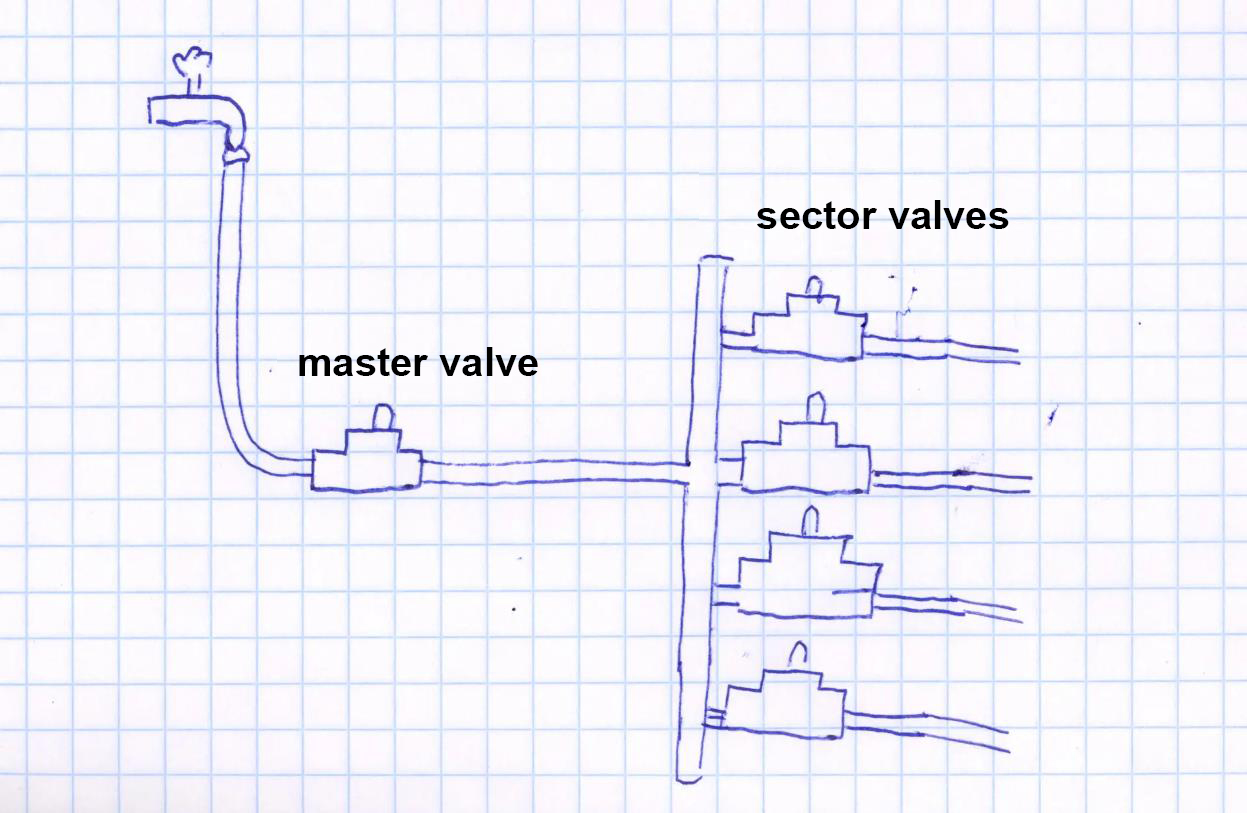
The master valve is placed in the irrigation system before the sector valves
Pump control
A pump control can be used as an alternative to a master valve. As described above, you need an irrigation controller that supports a master valve. In this case, instead of connecting the master output to a valve, it is connected to a pump controller (a pump start relay (Amazon Link)) to switch a connected pump on and off. The functionality and the advantages and disadvantages are the same as previously described for the master valve.
Water flow meter
A water flow meter measures how much water the irrigation system uses. In order to use a flow meter to monitor irrigation, the irrigation controller must be able to communicate with a flow meter. This requires a modern irrigation computer such as a Hunter Hydrawise computer or a Rain Bird ESP-M3 controller. With the faucet control computers, the LinkTap G2 computer offers this option; none of the Gardena computers are compatible with flow meters.
A suitable irrigation computer, in combination with a flow meter, offers the possibility to monitor the following things:
- Is the water consumption of a sector higher than the usual consumption?
- Is water consumed even though no sector was active?
This identifies both of the problems mentioned at the beginning of the report. And with computers like Hunter Hydrawise, you can be notified automatically by push message on your mobil phone or by e-mail if one of the defined rules exceeds or falls below the limit value. With the use of a water flow meter, you are automatically informed when the water consumption exceeds the usual level and you also notice if an irrigation should not run unexpectedly and you can react to problems very quickly. In some irrigation programs it can also be specified that the master valve is closed when certain limit values are reached, so that further water leakage is prevented.
If the irrigation computer used does not support a water flow meter, you can use an autonomous water flow meter. In this case, the flow sensor is simply installed in the line and the threshold value from which an alarm is to be triggered is programmed into the associated control panel. The alarm can then either be output as an acoustic warning signal or the sensor switches a relay, which can then be used to activate a pump or a solenoid valve, for example.
Protection over the pump
Modern pumps such as the Grundfos Scala include intelligent monitoring functions that can be used to identify problems in the irrigation system and subsequently stop the pump function. For example, a maximum runtime of the pump can be set, after which the pump switches off automatically. If you know, for example, that the watering runs last a maximum of 3 hours all in all, then you can set the maximum running time at 4 hours and thus have the certainty that the pump would switch off automatically if the watering did not stop after the scheduled time.
In addition, a modern pump also detects minimal leaks that lead to repeated switching on and off of the pump and switches the pump off after a user-specified number of consecutive switching on and off in exactly the same pattern. This way you can quickly track down small leaks and fix them as quickly as possible. This not only saves water, but also protects the pump, for which frequent short starts within a short period of time are not good.
Solenoid valve monitoring via the irrigation computer
Modern irrigation controllers such as the Hunter Hydrawise computers and the Rain Bird ESP-TM2, ESP-ME and ESP-ME3 series computers have a built in feature that monitors that the current flow to the solenoid valves is at the expected level. A value that is too low indicates a defective cable, and a value that is too high indicates a short circuit in the magnetic coil. As soon as there is a deviation from the norm, you are notified immediately so that problems can be identified and rectified as early as possible. Hunter calls this function an integrated milliampere sensor, Rain Bird speaks of automatic short-circuit detection.
More options
When watering from a cistern with automatic water replenishment, additional protection can be provided via a water level switch. The main danger here is that water is refilled unchecked, even though the cistern is already full and the excess water runs out unnoticed for hours or days via the overflow. The water level switch automatically switches off the refilling pump or activates an alarm when a certain water level mark is exceeded, at which point the water will overflow.
An alternative way to force a pump to turn off after a certain amount of time is to use a time delay relay (Amazon Link). After activation, this counts down a user-defined time countdown from a few seconds to several days and then switches off. This is referred to as a switch-off delay.
